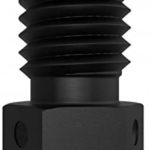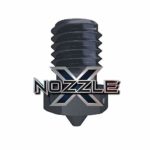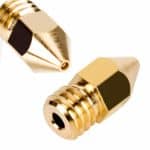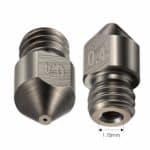Best 3D Printer Nozzle in 2022
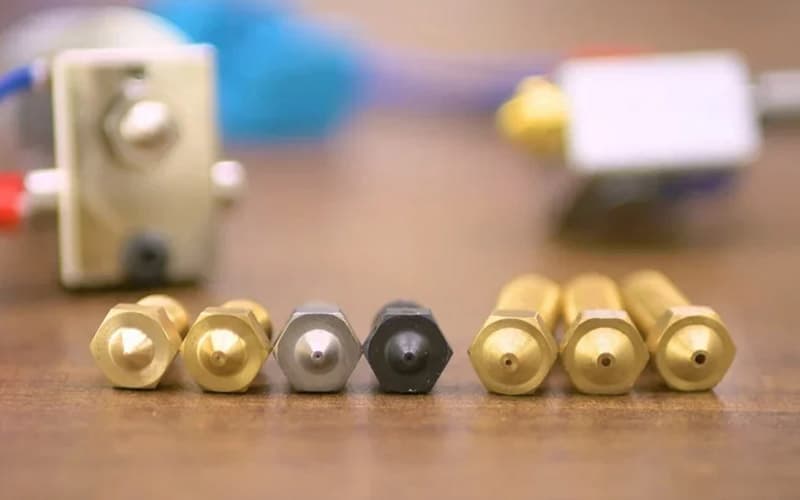
Tasked with depositing filament on the print bed to bring 3D prints to life, the nozzle has one of the most demanding jobs of any of the constituent parts of a 3D printer. It is the part that has the most significant impact on the final quality of your creations, not to say how long the printing process takes, and as such, it’s well worth spending some time to find the right nozzle to level up your 3D printing experience.
With the ever-rising popularity of 3D printing, there are countless nozzles of varying diameters and types to choose from as manufacturers bring more and more options to the market, which can test even the most patient builders trying to figure which one is best for their needs and aims. Which is the best 3D printer nozzle?
To answer that very question, we’ve pieced together this helpful guide highlighting some of the best nozzle options currently available. If you’re on the verge of pulling your hair out and need some pointers to ease the process, you’ve come to the right place.
Products at a Glance
How we picked
So, how did we pick the best 3D printer nozzles? To help us sort through the numerous options out there, we focused our search on multiple key factors, specifications, and features that define every nozzle: size, diameter, build quality and materials (steel, brass, etc.), supported filament, known issues such as clogging, and, of course, real-world printing performance.
After scouring the market, we narrowed our selection to four nozzles that strike a careful balance of all the above to deliver the best printing experience at several different price points. It goes without saying that there are plenty of other great nozzles out there, but for the purpose of this article, we’ve had to slim down our selection. If you feel we’ve missed out on some top choices, don’t hesitate to let us know in the comment section below.
Read on to find out what each brings to the table, where they fall short, and where they shine brightest. For those that require a bit more guidance on what to look for when shopping for a 3D printer nozzle, you’ll find a handy ‘Things to Consider’ section at the end.
Things to consider
Nozzle Material
3D printer nozzles come in a variety of materials, each suited to different applications. Among these materials, brass, stainless steel, and hardened steel are the most common, with more rugged and hardy materials like tungsten are also used in a few select nozzles. There are also assembled nozzles that pair two or three different materials, such as reinforced steel and a ruby tip. Here’s a brief outline of the most widely used materials.
Brass – by far the most common, brass nozzles are favored for their thermal conductivity, low maintenance, and low cost. They tend to pair well with more pliable filaments such as polymers like ABS and PLA, but due to their reasonably brittle nature, they aren’t suited to more abrasive materials such as carbon fiber and metal. Brass nozzles have a shorter life span than other materials.
Stainless Steel – more resistant to erosion and general wear and tear than brass, stainless steel nozzles work better with coarse materials such carbon fiber, NylonX, metal-infused filament, and the like. They are also prized for lead-free printing, particularly important for prints made of FDA-approved filament and suitable for medical and food applications. This extra resistance to abrasive materials does come at a cost to thermal conductivity, though.
Hardened Steel – by far the most durable and rugged, hardened steel nozzles are the most expensive but are designed to handle the stresses of abrasive materials day in, day out, and have the best life span of any nozzle type. Much like stainless steel, thermal conductivity takes yet another hit. The internal lining of the nozzle is rougher than other options, which can affect extruding precision and the final quality of prints.
Bore Diameter
3D printer nozzles are available in a variety of diameters, each adapted to different applications and uses. Bore diameters are available in these standard sizes: 0.1 mm, 0.25 mm, 0.3 mm, 0.4 mm, 0.5 mm, 0.6 mm, 0.8 mm, 1.0 mm. However, 0.4 mm is by far the most popular, and chances are this is what you’ll want for a balance between accuracy and reasonable print times.
As a general rule, larger bore diameters print faster, extrude more filament in larger layers, are less likely to cause errors or clogging, and are best suited to coarser filament types. The size does limit the detail and precision you can expect from a final print, which is worth keeping in mind.
On the other hand, small bore diameters offer better precision and finer details because they allow for smaller layer heights, but at a cost to print speeds and a heightened chance of issues, notably clogging. Additionally, they fare better when used with more flexible, smooth materials such as ABS and PLA.
Best 3D Printer Nozzle in 2022
- Reputable brand
- Available in a range of bore diameters
- Durable
- Smooth, consistent prints
- Reasonably priced
- Thermoplastic printing
E3D is one of the most respected nozzle manufacturers in 3D printing, chiefly because they are responsible for producing the popular V6 hot end found in so many 3D printer extruders. As such, their nozzles are designed for compatibility with a vast swathe of 3D printers and are quality products to boot.
The E3D Hardened Steel Nozzle is a prime option for those looking to experiment and print with abrasive materials such as carbon fiber, wood-based filaments, and metal-filled types. While the E3D Hardened Steel Nozzle is undoubtedly capable of handling thermoplastic filament like PLA and ABS, there are better options out there for those primarily using such materials that don’t require as much temperature tinkering to produce impressive prints.
The high-quality black hardened steel construction is among the most durable out there, suitable for years of use. The nozzle can support temperatures up to 500 degrees, plenty to mitigate the higher temperatures needed to make the most of hardened steel nozzles. A smooth interior lining ensures clogs are rare, perfect for those looking for a reliable nozzle.
With the aim of offering builders plenty of options, the E3D Hardened Steel Nozzle ships in a broad range of sizes suitable for both 1.75 mm and 2.85 mm filament, covering every application from detail-oriented miniatures to large practical creations. The sizes offered include 0.25 mm, 0.3 mm, 0.35 mm, 0.4 mm, 0.5 mm, 0.6 mm, and 0.8 mm.
Lastly, one of the most attractive features of the E3D Hardened Steel Nozzle is the price point, which considering the quality and durability of the nozzle, is reasonable.
- Extremely durable
- Three material construction
- Anti-stick coating
- Affordable
- Finicky temperature configuration
Another great option from the folks at E3D, the E3D Nozzle X is one of the more versatile options out there because of its unique construction, which marries a hardened tool-steel base with a nickel plating and a WS2 ‘polyphobic’ nano-coating.
The novel design aims to combine the abrasion resistance of hardened steel and the high-temperature resistance of materials like copper to create a nozzle that is extremely hard and durable and can handle temperatures without softening. The result is that the E3D Hardened Steel Nozzle can confidently print a range of materials, everything from abrasive carbon fiber-filled PEEK to nylon by way of thermoplastics.
The nano-coating works to ensure hot filament doesn’t stick to the nozzle surface to drastically reduce build-up, improve first-layer deposition, promote smooth layering throughout a print, and guarantee easy maintenance.
E3D is so confident in the durability of the Nozzle X that the company offers a lifetime wear warranty: should the nozzle wear out, E3D will replace it free of charge, no questions asked.
Additionally, the E3D Nozzle X is extremely affordable for what is essentially a ‘nozzle to rule them all’ as E3D puts it. Much like the hardened steel variant, E3D Nozzle X variants for both 1.75 mm and 2.85 mm filament are available, as are the following bore diameters: 0.25 mm, 0.3 mm, 0.35 mm, 0.4 mm, 0.5 mm, 0.6 mm, and 0.8 mm.
The only complaint we can throw at the Nozzle X is that temperature configuration can verge on the complex when paired with certain printers and materials. Beginners may find the troubleshooting offputting and may prefer to opt for a more user-friendly brass alternative.
- Compatible with MK8 extruder
- Brass nozzle
- Available as a set with a range of bore diameters
- Great results with thermoplastic filament
- Cheap
- Not suitable for abrasive materials
- Machining lottery can lead to dud batches
Being the most popular type of nozzle, brass nozzles are the most prone to wear and tear, especially for particularly prolific makers. The LUTER Extruder Nozzles stand as a low-cost way to swap out a tired nozzle on a printer equipped with an MK8 type hot end.
They are widely compatible with many 3D printers, including popular models such as the Makerbot Creality CR-10, MK8 Makerbot Reprap Prusa I3, and most other 1.75mm PLA ABS 3D printers equipped with extruders sporting an external M6 thread. Print results are smooth using the LUTER Extruder Nozzles, and they work well to avoid errors and clogging thanks to a rounded chamfer despite their low cost.
Perhaps the most attractive feature of the LUTER Extruder Nozzles is the range of bore diameters included in the set (conveniently housed in a plastic case for easy storage): 2 x 0.2 mm, 2 x 0.3 mm, 12 x 0.4 mm, 2 x 0.5 mm, 2 x 0.6 mm, 2 x 0.8 mm, 2 x 1.0 mm.
It goes without saying that as brass-based nozzles, the LUTER Extruder Nozzles aren’t suitable for coarse, abrasive materials. Using them with anything other than PLA or ABS grinds away at the nozzles’ innards, causing them to be virtually unusable due.
The LUTER Extruder Nozzles are generally well-machined, but dud batches with threading issues and clogging problems have been known to crop up here and there. To counter this, we recommend buying from a retailer with a robust return policy to source a replacement quickly.
- Hardened steel construction
- Suitable for MK8 hot ends
- Ship in a set of four
- Popular 0.4 mm bore diameter
- Durable and resistant to wear, heat, and corrosion
- Higher temperatures required for good results
- Poor performance with thermoplastics
Those looking to tinker with coarse materials and needing an upgrade from a comparatively more fragile brass nozzle should consider the Mudder Hardened Steel Nozzle. Priced affordably and shipped in sets of either five, ten, or fifteen nozzles, the Mudder Hardened Steel Nozzle features a bore diameter of 0.4 mm and support for 1.75 mm filament – one of the most popular and versatile configurations given their best of both worlds capabilities that balance precision and print speeds. Compared to E3D hardened steel nozzles, these are considerably more affordable.
The hardened steel construction makes the Mudder Hardened Steel Nozzle suitable for abrasive materials such as carbon-fiber fills, fiberglass, and metal-infused filament. The thermoformed steel ensures resistance to wear, corrosion, and heat to reduce softening and guarantee durability over the long term, even after prolonged use. Hardness tallies up to 50 HRC.
As such, the nozzle performs rather poorly with thermoplastics due to the need to push much higher temperatures than brass nozzle options. Even with suitable materials, temperatures do need to be adjusted accordingly to get good results.
It’s worth noting that the Mudder Hardened Steel Nozzle is designed to pair with printers using MK8 hot ends, specifically the Creality Ender-2, Creality Ender-3, Creality Ender-3 Pro, Creality Ender-5, Creality CR-10, Prusa i3, Anet A8, and Reprap printers.
The machining lottery does play its role here, so defects do pop up occasionally, but nothing a quick return won’t solve.
Are 3D printer nozzles interchangeable?
To an extent, yes, 3D printer nozzles are interchangeable. However, just because some can be interchangeable, this does not mean that they are universal.
For the vast majority of 3D printers, you will only be able to use nozzles that are created by the manufacturer. This is because you need to ensure that it is compatible and will fit the printer.
When it comes to choosing a 3D printer nozzle, there are many options you can choose from. The size of the nozzles can vary significantly. If all the nozzles that you own are compatible with your 3D printer, then yes, they are interchangeable.
You can switch between the compatible nozzles easily, with no issues. However, can should be taken when purchasing new nozzles. If the nozzle does not quite fit on to your 3D printer, it is not compatible. It should connect easily without it being forced.
When looking at different nozzle attachments, it is likely that you will come across non-branded options. While these can be tempting to consider, especially as they tend to be significantly cheaper, it is not guaranteed that they will be compatible.
Given this, we do not feel as though it is worth the risk. By purchasing the correct nozzles that are intended to work with your 3D printer, the quality of your design will not be compromised, and you know that it will be guaranteed to work correctly.
Are steel nozzles better?
When it comes to 3D printer nozzles, there are a number of different choices available. Some of the options available include – brass, copper plated, steel, hardened steel, non-coated, ruby, and copper.
The nozzles are made with metal as molten plastic is pumped through them. Given this, it is essential that the nozzles are created using a strong and durable metal that is not going to melt.
While many people believe that steel nozzles are the best choice over the other options we have included, this is not necessarily true. It does depend on the quality of the nozzle, and how it was manufactured.
Different nozzle types have their own advantages, and will work better with certain types of materials. When you purchase a 3D printer, it will typically come with a brass nozzle included. Brass nozzles are great when creating detailed objects, and are great for both ABS, and PLA.
When it comes to using abrasive materials, this is when you will want to use a steel nozzle. This is because steel nozzles are stronger, and work better with this sort of material. They are great for use with PLA carbon Fiber.
While food is not used often in 3D printing, it is possible. If you are looking to use chocolate, for example, you will want to use a stainless steel nozzle that has been approved for this purpose.
On the whole, steel nozzles are not necessarily better, as all nozzles serve different purposes. However, if you are using abrasive materials it is the best choice.
Our Verdict
Leveraging one of the most respected names in the 3D printing world, the E3D Hardened Steel Nozzle proposes an easy way to transform any V6 hot end into an abrasive material printing workhorse. With quality etched into every nook and cranny of the nozzle, the slightly higher price is warranted, although entirely reasonable in the grand scheme of 3D printing costs, especially as the E3D Hardened Steel Nozzle should last for years to come and produce consistent prints.
Similarly impressive is the E3D Nozzle X. Designed with versatility in mind, this nozzle marries some of the best characteristics of different nozzle types to create an option capable on all fronts and compatible with numerous filament types. A top choice for makers that want to experiment untethered to a brass or steel nozzle.
Brass nozzles wear, and if you’re in the market for an upgrade but don’t want to break the bank, then the LUTER Extruder Nozzles are a value-packed, low-cost level up as long as you have a compatible 3D printer with an MK8 extruder. The range of sizes and multiple pieces of each bore diameter also give makers plenty of options to create everything from detailed miniatures to larger, functional prints.
Finally, the Mudder Hardened Steel Nozzle is an affordable way to modify a 3D printer to confidently tackle coarse materials such as metal-filled filament, all while keeping costs down.
We’ll now wrap up our guide to the best 3D printer nozzles. Don’t hesitate to hit us up in the comments section below with any recommendations of your own or questions and concerns.


